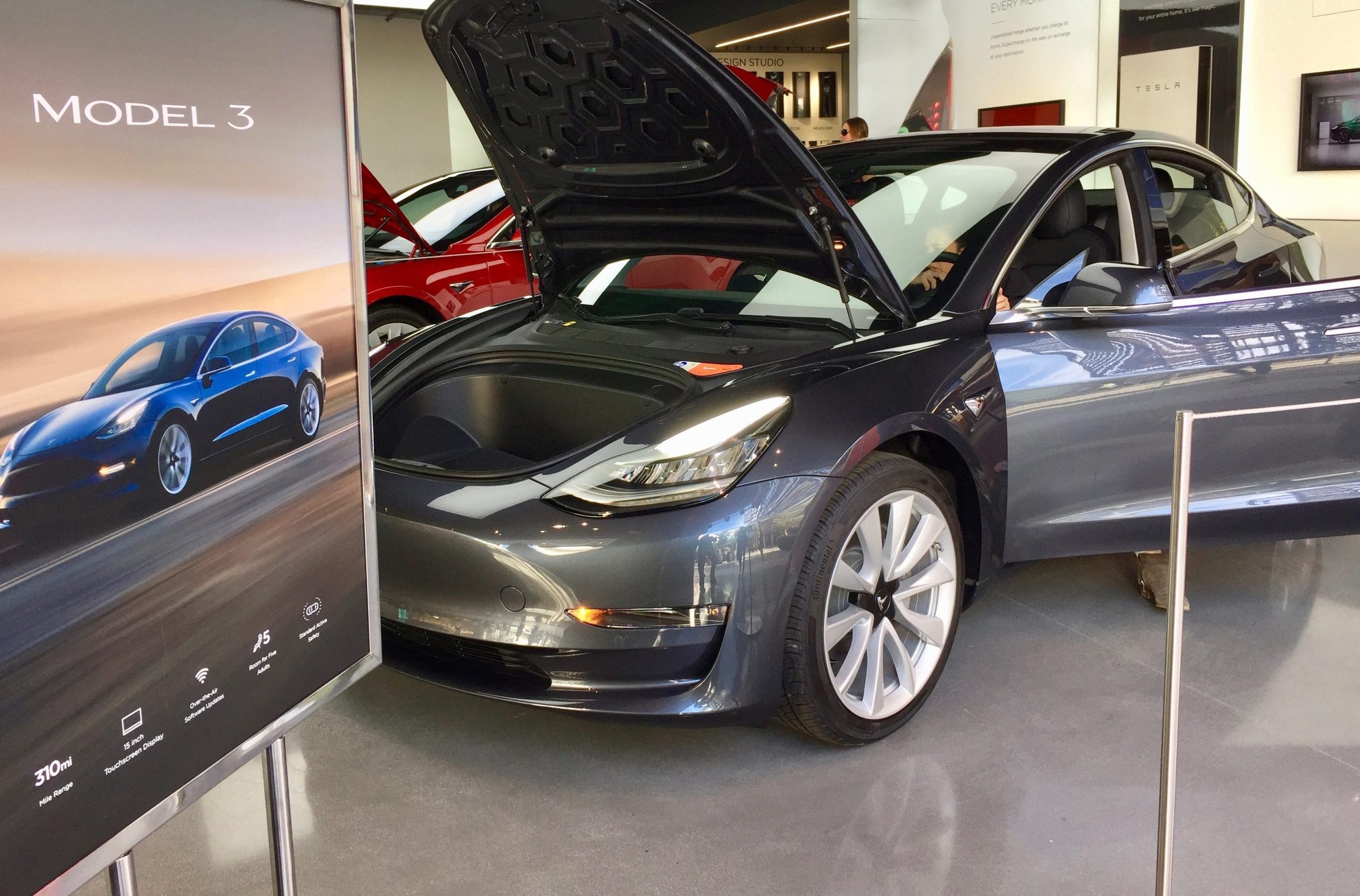
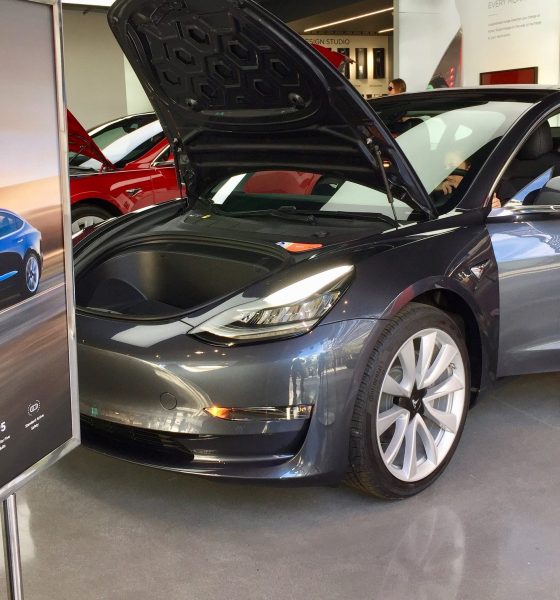
News
Tesla opens up first Model 3 test drives in the San Francisco Bay Area
Tesla is beginning to offer its first Model 3 test drives in the San Francisco Bay Area to US customers that placed a reservation deposit on the all-electric compact sedan. The Silicon Valley electric carmaker chaperoned Model 3 test drives on Friday from its Dublin-Amador Plaza, Corte Madera, Sunnyvale, and Palo Alto showroom stores, and expected to extend the test drive program to its San Jose, Burlingame, San Francisco, and Palo Alto store in the Stanford Shopping Center soon after.
The first Model 3 test drives in the Bay Area come ahead of Tesla’s nationwide summer rollout, where Model 3 reservation holders will be able to set appointments for test drives from Tesla’s official website.
Tesla’s test drives are available for individuals with a valid driver’s license who are 21 years old and above. If the Tesla showroom is located in a shopping mall, individuals are first required to check in at the showroom and given a brief overview before being directed to a Tesla product specialist. Tesla’s official website states that test drives are usually 15 minutes long to demonstrate the capabilities and performance of its electric cars, although anecdotes from the online community state that Tesla’s test drives could, at times, extend well beyond the 15-minute mark.
Considering that Tesla still has hundreds of thousands of Model 3 customers and high demand to experience the vehicle first-hand, it’s presumed that Model 3 test drives would be held to a strict time-boxed schedule.
Although first test drive vehicles in the Bay Area are the non-Performance variant, the company will introduce Model 3 Performance into its test drive fleet soon.
Model 3 Performance order page progressively rolling out to reservation holders over the next week or so. It’s a really great car. Not saying that lightly. Test drive is a mindwarp. Aiming to have these as our first test drive Model 3 cars in stores within 4 to 6 week’s.
— Elon Musk (@elonmusk) June 3, 2018
Having the Model 3 Performance as the test drive units for the compact electric car could be seen as a strategic move for Tesla, which is currently attempting to hit profitability this third quarter. The Model 3 Performance, after all, is the top tier variant of the electric car, with the vehicle starting at $64,000 before options. With all options including white seats, the “Performance Package,” premium paint, Autopilot and Full Self-Driving, the Model 3 Performance costs $80,000, a significant premium over the vehicle’s base price of $35,000. With this in mind, every reservation holder that upgrades their order to the Model 3 Performance after test driving the car is another drop in the bucket for Tesla’s revenue this Q3 2018.
Tesla has managed to hit its ever-elusive target of producing 5,000 Model 3 per week by the end of the second quarter. With this milestone achieved, Tesla finally seems ready to start taking in more reservations for the vehicle. As of date, Tesla expects deliveries for reservations of the Model 3 to be delivered in 2-4 months. Orders for the Long Range RWD variant are listed with an estimated delivery time of 3-5 months, and reservations for the $35,000 base model with a standard battery are listed with an estimated delivery time of 6-9 months.

News
Tesla is improving Giga Berlin’s free “Giga Train” service for employees
With this initiative, Tesla aims to boost the number of Gigafactory Berlin employees commuting by rail while keeping the shuttle free for all riders.

Tesla will expand its factory shuttle service in Germany beginning January 4, adding direct rail trips from Berlin Ostbahnhof to Giga Berlin-Brandenburg in Grünheide.
With this initiative, Tesla aims to boost the number of Gigafactory Berlin employees commuting by rail while keeping the shuttle free for all riders.
New shuttle route
As noted in a report from rbb24, the updated service, which will start January 4, will run between the Berlin Ostbahnhof East Station and the Erkner Station at the Gigafactory Berlin complex. Tesla stated that the timetable mirrors shift changes for the facility’s employees, and similar to before, the service will be completely free. The train will offer six direct trips per day as well.
“The service includes six daily trips, which also cover our shift times. The trains will run between Berlin Ostbahnhof (with a stop at Ostkreuz) and Erkner station to the Gigafactory,” Tesla Germany stated.
Even with construction continuing at Fangschleuse and Köpenick stations, the company said the route has been optimized to maintain a predictable 35-minute travel time. The update follows earlier phases of Tesla’s “Giga Train” program, which initially connected Erkner to the factory grounds before expanding to Berlin-Lichtenberg.
Tesla pushes for majority rail commuting
Tesla began production at Grünheide in March 2022, and the factory’s workforce has since grown to around 11,500 employees, with an estimated 60% commuting from Berlin. The facility produces the Model Y, Tesla’s best-selling vehicle, for both Germany and other territories.
The company has repeatedly emphasized its goal of having more than half its staff use public transportation rather than cars, positioning the shuttle as a key part of that initiative. In keeping with the factory’s sustainability focus, Tesla continues to allow even non-employees to ride the shuttle free of charge, making it a broader mobility option for the area.
News
Tesla Model 3 and Model Y dominate China’s real-world efficiency tests
The Tesla Model 3 posted 20.8 kWh/100 km while the Model Y followed closely at 21.8 kWh/100 km.
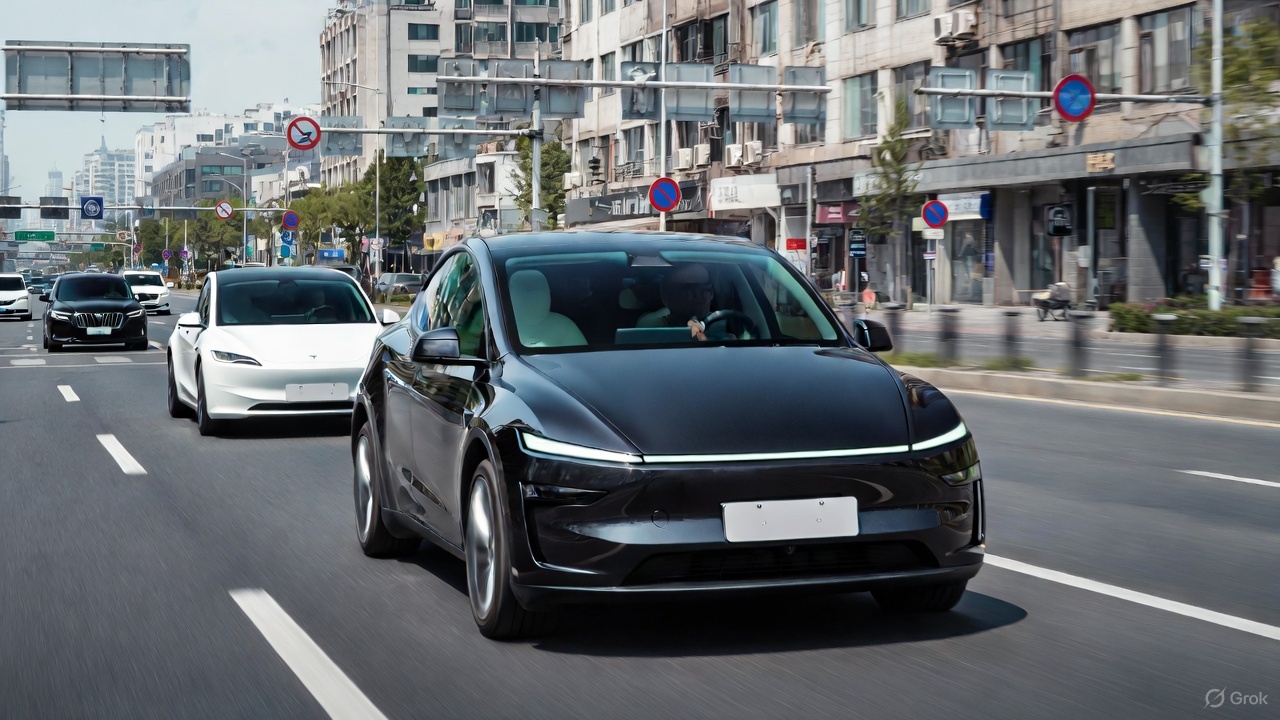
Tesla’s Model 3 and Model Y once again led the field in a new real-world energy-consumption test conducted by China’s Autohome, outperforming numerous rival electric vehicles in controlled conditions.
The results, which placed both Teslas in the top two spots, prompted Xiaomi CEO Lei Jun to acknowledge Tesla’s efficiency advantage while noting that his company’s vehicles will continue refining its own models to close the gap.
Tesla secures top efficiency results
Autohome’s evaluation placed all vehicles under identical conditions, such as a full 375-kg load, cabin temperature fixed at 24°C on automatic climate control, and a steady cruising speed of 120 km/h. In this environment, the Tesla Model 3 posted 20.8 kWh/100 km while the Model Y followed closely at 21.8 kWh/100 km, as noted in a Sina News report.
These figures positioned Tesla’s vehicles firmly at the top of the ranking and highlighted their continued leadership in long-range efficiency. The test also highlighted how drivetrain optimization, software management, and aerodynamic profiles remain key differentiators in high-speed, cold-weather scenarios where many electric cars struggle to maintain low consumption.
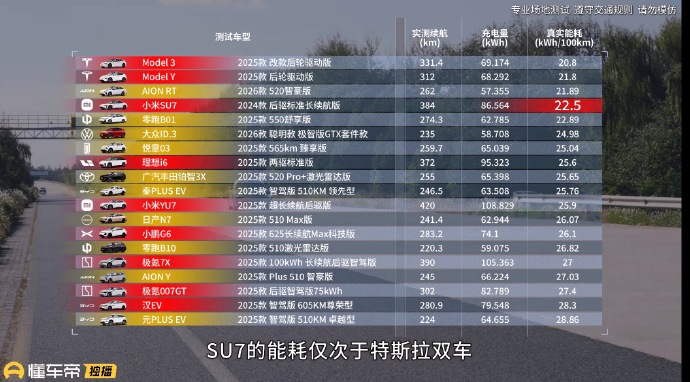
Xiaomi’s Lei Jun pledges to continue learning from Tesla
Following the results, Xiaomi CEO Lei Jun noted that the Xiaomi SU7 actually performed well overall but naturally consumed more energy due to its larger C-segment footprint and higher specification. He reiterated that factors such as size and weight contributed to the difference in real-world consumption compared to Tesla. Still, the executive noted that Xiaomi will continue to learn from the veteran EV maker.
“The Xiaomi SU7’s energy consumption performance is also very good; you can take a closer look. The fact that its test results are weaker than Tesla’s is partly due to objective reasons: the Xiaomi SU7 is a C-segment car, larger and with higher specifications, making it heavier and naturally increasing energy consumption. Of course, we will continue to learn from Tesla and further optimize its energy consumption performance!” Lei Jun wrote in a post on Weibo.
Lei Jun has repeatedly described Tesla as the global benchmark for EV efficiency, previously stating that Xiaomi may require three to five years to match its leadership. He has also been very supportive of FSD, even testing the system in the United States.
Elon Musk
Elon Musk reveals what will make Optimus’ ridiculous production targets feasible
Musk recent post suggests that Tesla has a plan to attain Optimus’ production goals.
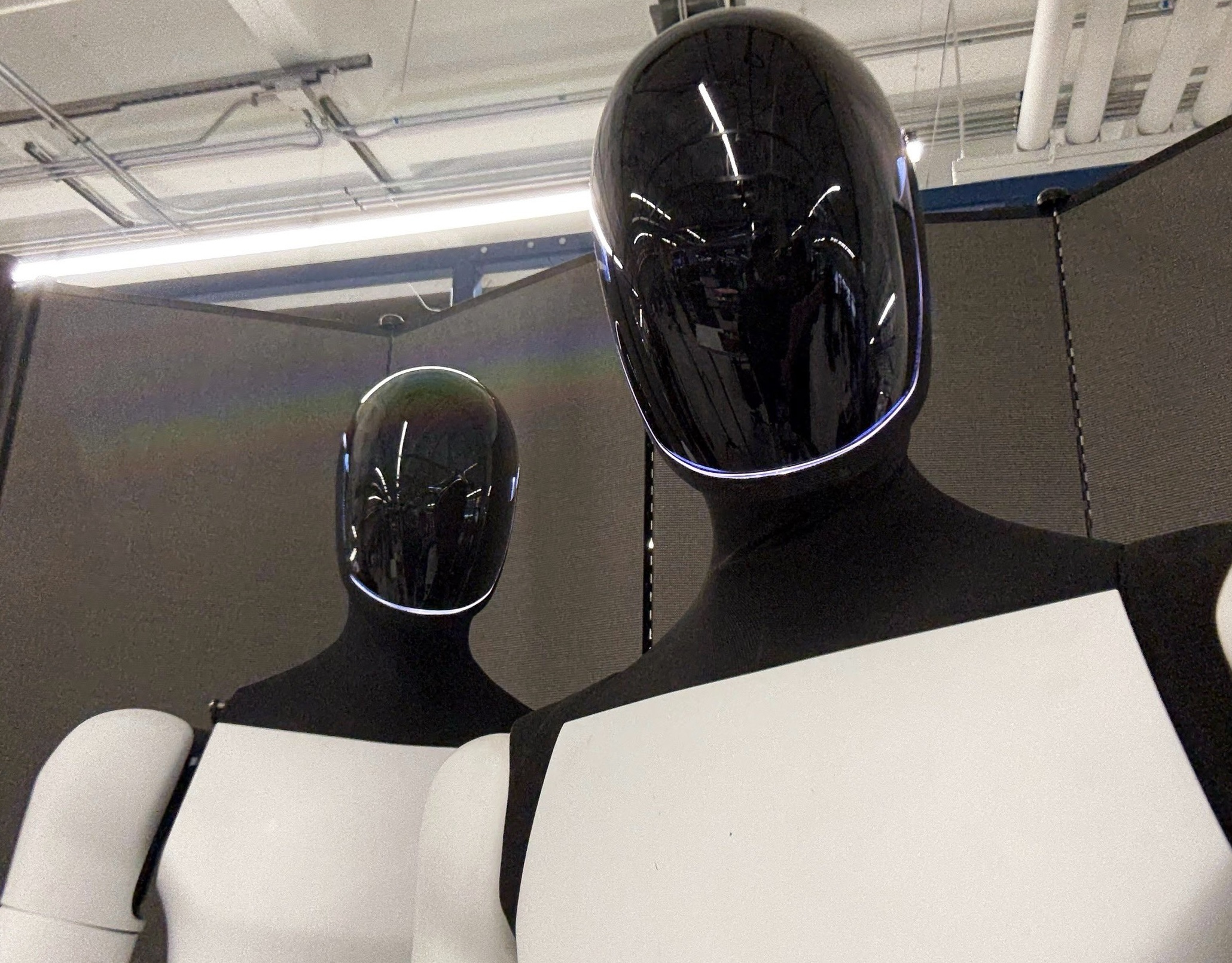
Elon Musk subtly teased Tesla’s strategy to achieve Optimus’ insane production volume targets. The CEO has shared his predictions about Optimus’ volume, and they are so ambitious that one would mistake them for science fiction.
Musk’s recent post on X, however, suggests that Tesla has a plan to attain Optimus’ production goals.
The highest volume product
Elon Musk has been pretty clear about the idea of Optimus being Tesla’s highest-volume product. During the Tesla 2025 Annual Shareholder Meeting, Musk stated that the humanoid robot will see “the fastest production ramp of any product of any large complex manufactured product ever,” starting with a one-million-per-year line at the Fremont Factory.
Following this, Musk stated that Giga Texas will receive a 10 million-per-year unit Optimus line. But even at this level, the Optimus ramp is just beginning, as the production of the humanoid robot will only accelerate from there. At some point, the CEO stated that a Mars location could even have a 100 million-unit-per-year production line, resulting in up to a billion Optimus robots being produced per year.
Self-replication is key
During the weekend, Musk posted a short message that hinted at Tesla’s Optimus strategy. “Optimus will be the Von Neumann probe,” the CEO wrote in his post. This short comment suggests that Tesla will not be relying on traditional production systems to make Optimus. The company probably won’t even hire humans to produce the humanoid robot at one point. Instead, Optimus robots could simply produce other Optimus robots, allowing them to self-replicate.
The Von Neumann is a hypothetical self-replicating spacecraft proposed by the mathematician and physicist John von Neumann in the 1940s–1950s. The hypothetical machine in the concept would be able to travel to a new star system or location, land, mine, and extract raw materials from planets, asteroids, and moons as needed, use those materials to manufacture copies of itself, and launch the new copies toward other star systems.
If Optimus could pull off this ambitious target, the humanoid robot would indeed be the highest volume product ever created. It could, as Musk predicted, really change the world.









